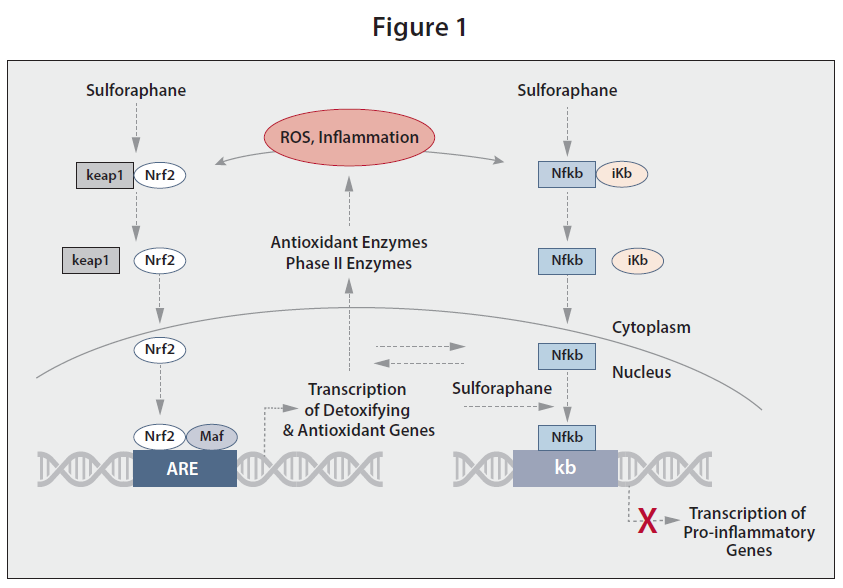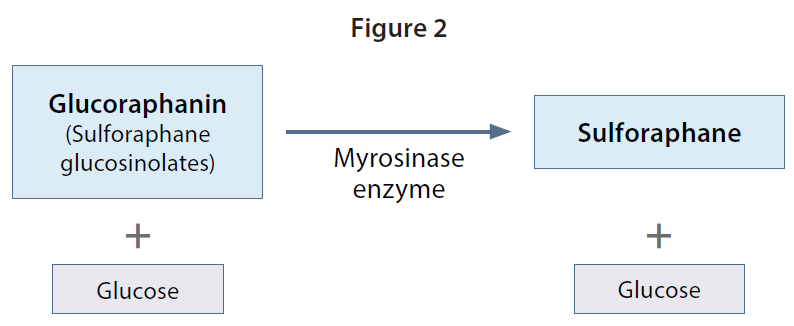Sulforaphane is a type of isothiocyanate and a metabolite of
glucoraphanin—a phytonutrient found in cruciferous vegetables, such
as broccoli, Brussels sprouts, and cabbage.1 Studies show that high
consumption of cruciferous vegetables is associated with reduced risk
of total and cardiovascular disease mortality.2
| Download the PDF |
Mechanism of Action
Sulforaphane appears to be a potent activator of the cellular antioxidant
pathway Keep1/Nrf2/ARE and other anti-inflammatory mechanisms,
including inhibition of the Nfkb pathway (Figure 1).3-4
Sulforaphane works to protect cells against harmful agents by helping
to turn on antioxidant genes—thus allowing the body to produce
antioxidant enzymes.
These enzymes produce anti-inflammatory and detoxification activities that help protect against chronic conditions (Figure 1).

Research Highlights
- Sulforaphane is a well-studied isothiocyanate due to its
antioxidant, anti-inflammatory, and detoxification properties3 - Sulforaphane modulates the nuclear factor-kappa B (NFkB)
pathway, a central regulator of DNA transcription and
pro-inflammatory cytokine production4 - Sulforaphane is produced only when the enzyme myrosinase
comes into contact with glucoraphanin5 - Increased levels of cellular stress are a common characteristic
of numerous conditions, such as cardiovascular disease,
cancer, and Alzheimer’s. Sulforaphane has been shown
to help mediate the protective protein Nrf2, which serves
as a main regulator of the body’s protective antioxidant
responses against cellular stress6
Inflammation
Sulforaphane has also been shown to reduce inflammation—a key
underlying mechanism in many chronic diseases, such as cardiovascular
disease, Crohn’s, diabetes, and COPD. Key factors in sulforaphane’s
anti-inflammatory properties include its capability to bind to the toll-like
receptor-4 (TLR4) in addition to blocking the activation of its downstream
transcription factor, known as NFkB, which is responsible for controlling
and signaling the expression of several pro-inflammatory cytokines (LPS,
TNF-α, CRP, IL-6, etc.) in response to inflammatory signals.9
H. pylori
Helicobacter pylori (H. pylori) is a bacterium strongly associated with
inflammation of the stomach lining, ulcers, and increased risk of stomach
cancer. H. pylori infections express high urease activity, which generates
ammonia, neutralizes gastric acidity, and promotes inflammation. Studies
conclude the bactericidal activity of sulforaphane leads to the inactivation
of H. pylori urease, which may reduce inflammation.11
Carcinogenesis
Dietary chemopreventive isothiocyanates, including sulforaphane, have
well established anti-cancer properties.7 Sulforaphane is a monofunctional
inducer since it selectively increases Phase II detoxification enzyme
activities without affecting Phase I biotransformation enzymes
(cytochrome P450).7 Along with antioxidant enzymes (glutathione
S-transferases), Phase II detoxification protects cells from carcinogens and
reactive oxygen species (ROS) via the Nrf2 pathway.6
Neurodegenerative Conditions
Several in-vitro and in-vivo studies have demonstrated sulforaphane’s
potential to act as a neuroprotective agent in models of neurodegenerative
disorders, such as Alzheimer’s and Parkinson’s disease. This protective
mechanism is likely due to sulforaphane’s ability to activate the
Nrf2/ARE pathway.8
Detoxification
Phases I and II of detoxification are necessary for the elimination of
harmful substances, such as carcinogens, aflatoxins, food additives, and
environmental pollutants. Phase II enzymes are induced by the Nrf2
pathway, which prevents the accumulation of harmful metabolites and
allows for inactivation or rapid excretion before they cause damage to
critical cellular molecules.1 Not only is sulforaphane a very potent inducer
of Phase II enzymes, it also raises cellular glutathione levels via the Nrf2/
ARE pathway.6,10
Myrosinase Enzyme
Myrosinase enzyme is necessary for the conversion of glucoraphanin to
sulforaphane. This enzyme is activated when the cruciferous plant tissue
is crushed, chewed, or chopped but is inactivated when subjected to
sustained boiling or heat, thus reducing the conversion of glucosinolates.12
Although myrosinase may also be produced by bacteria in the gut to
create sulforaphane from raw glucoraphanin, the conversion capabilities
vary and depend on the health of an individual’s gut microbiome.12

Conclusion
Activation of the myrosinase enzyme is required to convert glucoraphanin
to sulforaphane—an isothiocyanate with health-promoting properties.
After conversion, sulforaphane can yield various health benefits, such as
cellular health protection, Phase II detoxification support, neuroprotection,
and reduction of inflammation.


